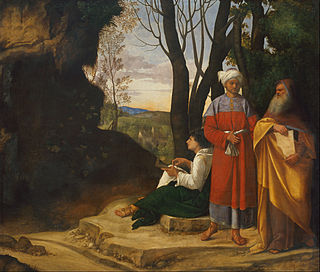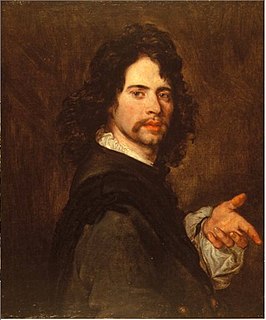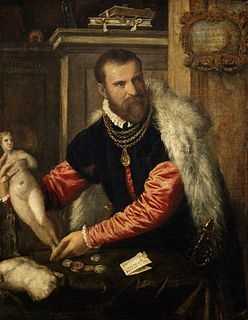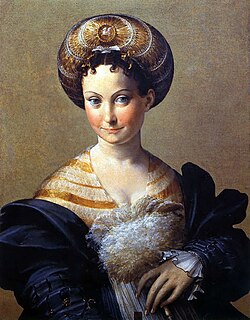
David Teniers the Younger or David Teniers II was a Flemish Baroque painter, printmaker, draughtsman, miniaturist painter, staffage painter, copyist and art curator. He was an extremely versatile artist known for his prolific output. He was an innovator in a wide range of genres such as history painting, genre painting, landscape painting, portrait and still life. He is now best remembered as the leading Flemish genre painter of his day. Teniers is particularly known for developing the peasant genre, the tavern scene, pictures of collections and scenes with alchemists and physicians.

Archduke Leopold Wilhelm of Austria, younger brother of Emperor Ferdinand III, was an Austrian soldier, administrator and patron of the arts.

The Three Philosophers is an oil painting on canvas attributed to the Italian High Renaissance artist Giorgione. It shows three philosophers – one young, one middle-aged, and one old. The work was commissioned by the Venetian noble Taddeo Contarini, a Venetian merchant with an interest in the occult and alchemy. The Three Philosophers was finished one year before the painter died. One of Giorgione’s last paintings, it is now displayed at the Kunsthistorisches Museum in Vienna. The painting was finished by Sebastiano del Piombo.

The Stallburg is a renaissance-style building in the Vienna city center located between Josefsplatz and Michaelerplatz. It is part of the Hofburg Palace.

Jan van den Hoecke was a Flemish painter, draughtsman and designer of wall tapestries. He was one of the principal assistants in Rubens' studio in the 1630s. He later traveled to Italy where he resided for a decade in Rome. He subsequently worked as a court painter in Vienna and Brussels. Jan van den Hoecke was a versatile artist who created portraits as well as history and allegorical paintings.

Robert van den Hoecke was a Flemish painter, engraver and architect. He is principally known for his panoramic battle scenes as well as his landscape paintings. A single still life by his hand is known.

Violante is an oil painting attributed to Titian, dated to around 1515 and now held at the Kunsthistorisches Museum in Vienna.

Flora is an oil painting by Italian late Renaissance painter Titian, dated to around 1515 and now held at the Uffizi Gallery in Florence.

The Portrait of Jacopo Strada is a 1567-68 portrait of the court librarian Jacopo Strada by Titian, now held in the Kunsthistorisches Museum in Vienna.

Turkish Slave is a painting by the Italian Mannerist artist Parmigianino, executed around 1533. It is housed in the Galleria nazionale di Parma, northern Italy.

Jan Anton van der Baren was a Flemish painter, draughtsman, priest and museum curator active in Brussels and Vienna. He specialised in still lifes of flowers and vegetables, some of which include an architectural background. He held the offices of court chaplain and director of the picture gallery of Archduke Leopold Wilhelm and Emperor Leopold I.

The Madonna of the Cherries is a 1515 painting by Titian, heavily influenced by the work of Giovanni Bellini. Originally oil on wood, it was later transferred to canvas. During the 17th century it formed part of the collection of Archduke Leopold Wilhelm, where it was copied by David Teniers. It is now in the Kunsthistorisches Museum in Vienna.

The Bravo is an oil painting usually attributed to Titian, dated to around 1516-17 and now in the Kunsthistorisches Museum in Vienna. The painting can be seen as one of a number of Venetian paintings of the 1510s showing two or three half-length figures with heads close together, often with their expressions and interactions enigmatic. Most of these are "Giorgionesque" genre or tronie subjects where the subjects are anonymous, though the group includes Titian's The Tribute Money, with Christ as the main figure, which in terms of style is similar to this painting, and his Lucretia and her Husband, also in Vienna, where at least the woman's identity is clear, if not that of the man.

Theatrum Pictorium, or Theatre of Painting, is a short-hand name of a book published in the 1660s by David Teniers the Younger for his employer, the Archduke Leopold Wilhelm of Austria. It was a catalog of 243 Italian paintings in the Archduke's collection of over 1300 paintings, with engravings of the paintings taken from small models that Teniers had personally prepared. A second edition with page numbers was published in 1673.

Judith with the head of Holofernes is a 1610–1615 painting by the painter Carlo Saraceni, now held in the Kunsthistorisches Museum in Vienna.

Saint Margaret and the Dragon is a circa 1518 painting of Saint Margaret by the Renaissance painter Raphael, now held in the Kunsthistorisches Museum in Vienna.

Gallery of Archduke Leopold Wilhelm in Brussels is a 1651 painting of Archduke Leopold Wilhelm's Italian art collection by the Flemish Baroque painter David Teniers the Younger, now held in Petworth House in England.

Archduke Leopold Wilhelm and the artist in the archducal picture gallery in Brussels is a 1651 painting of Archduke Leopold Wilhelm's Italian art collection by the Flemish Baroque painter David Teniers the Younger, now held in the Kunsthistorisches Museum in Vienna.

Bartolomeo della Nave was a Venetian merchant and art collector.

Mountain Landscape is a large oil on canvas painting by Flemish painter Joos de Momper. The painting was probably completed in the 1620s and is currently housed at the Kunsthistorisches Museum in Vienna.

























